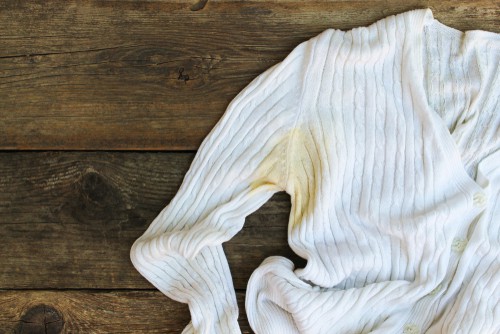
Sweat Stains on Your Clothes: Causes, Prevention, and Removal. Sweat stains on clothes are a common and often frustrating issue many individuals encounter.
These stains not only impact the appearance of our garments but can also affect our confidence.
In this comprehensive guide, we’ll delve into the world of sweat stains, exploring their causes, effective prevention strategies, and proven methods for their removal.
By understanding this issue more deeply, you can ensure your clothes stay fresh and stain-free.
Read on – Sweat Stains on Your Clothes: Causes, Prevention, and Removal:
The Common Dilemma
Sweat stains are a universal problem, irrespective of age, gender, or lifestyle.
Whether it’s a sweltering summer day, an intense workout session, or the stress of a high-pressure meeting, sweat can leave its mark on our clothing.
This common dilemma prompts the need for effective solutions to address sweat stains.
The Impact on Appearance
The presence of sweat stains can significantly affect the appearance of our clothing.
Yellow or white stains on our favorite shirts or blouses can be embarrassing and diminish our overall look.
Moreover, the awareness of these stains can dent our confidence, making us self-conscious about our appearance in social and professional settings.
Recognizing the impact of sweat stains on our clothing choices underscores the importance of effective prevention and removal methods.
Understanding Sweat Stains
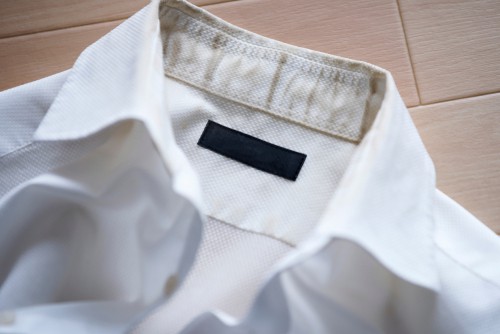
What Are Sweat Stains?
Sweat stains are the unsightly marks left on clothing when sweat interacts with the fabric.
Understanding how these stains form is essential in developing effective strategies for both prevention and removal.
When we sweat, our bodies excrete water, salt, and other substances.
This sweat is naturally odorless, but it can lead to stains when it comes into contact with the fabric of our clothing.
The interaction between the chemicals in sweat and the fibers of the fabric can result in the characteristic yellow or white discoloration we commonly associate with sweat stains.
Types of Sweat Stains
Not all sweat stains are created equal. There are two primary types of sweat stains: yellow and white.
Yellow sweat stains are often the most noticeable and challenging to remove.
They are caused by the interaction between the proteins in sweat and the aluminum compounds commonly found in antiperspirants.
Over time, these stains can become more pronounced and difficult to eliminate.
White sweat stains, on the other hand, are typically less noticeable but still problematic.
These stains result from the salt in sweat, which can accumulate on clothing and create a crusty or powdery residue.
While they may not discolor clothing as visibly as yellow stains, they can affect the texture and feel of the fabric.
Causes of Sweat Stains
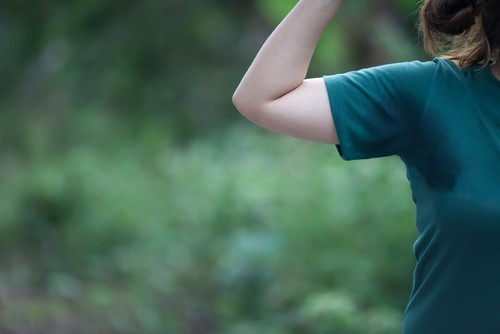
To effectively address sweat stains, it’s essential to understand why and when our bodies produce sweat.
Sweating is a natural bodily function aimed at regulating body temperature.
When we engage in physical activity, experience stress, or encounter high temperatures, our sweat glands are activated to release sweat.
Sweat serves as the body’s cooling mechanism. As it evaporates from our skin’s surface, it dissipates heat and helps lower our body temperature.
However, this vital function can inadvertently lead to sweat stains when sweat comes into contact with clothing.
Factors Contributing to Stains
Several factors contribute to the formation of sweat stains, making some individuals more prone to this issue than others.
Genetics can play a role, as some people naturally produce sweat with higher levels of proteins and minerals that are more likely to lead to stains.
Lifestyle choices, such as diet and activity levels, can also influence the composition of sweat and its staining potential.
Additionally, the type of antiperspirant or deodorant used can impact the severity of stains.
Aluminum-based antiperspirants, while effective in reducing sweat, can react with sweat and contribute to yellow stains over time.
The Role of Fabric
The choice of fabric in clothing can significantly influence the likelihood and severity of sweat stain formation.
Some fabrics are more prone to staining due to their absorbent nature. Cotton, for example, readily absorbs sweat and is more susceptible to staining.
On the other hand, moisture-wicking fabrics, designed to pull moisture away from the body, are less likely to develop noticeable stains.
Understanding the role of fabric can guide us in making informed choices when selecting clothing for different activities and environments.
Prevention Strategies
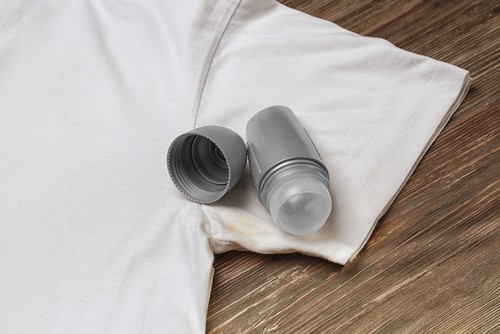
Choosing the Right Clothing
Choosing the right clothing is one of the most effective strategies for preventing sweat stains.
Opting for sweat-resistant fabrics and clothing types can make a significant difference.
Moisture-wicking fabrics, such as those used in athletic wear, are designed to keep sweat away from the skin’s surface, reducing the chances of stains.
Additionally, selecting clothing colors less likely to show sweat stains can be a practical choice.
Darker colors, patterns, and textured fabrics are often better at concealing sweat marks.
Antiperspirants vs. Deodorants
Understanding the difference between antiperspirants and deodorants is vital in preventing sweat stains.
Antiperspirants reduce the amount of sweat produced by temporarily blocking sweat ducts.
While they effectively minimize sweat, they can also contribute to yellow stains due to the aluminum compounds they contain.
Deodorants, on the other hand, focus on masking or neutralizing odor rather than reducing sweat.
They are less likely to lead to stains, making them suitable for individuals concerned about discoloration.
Proper Hygiene Habits
Maintaining personal hygiene is fundamental to minimizing sweating and sweat stains.
Regular showers and antibacterial soap can help control odor and reduce the accumulation of sweat on the skin’s surface.
Proper hygiene also includes thoroughly drying the skin before putting on clothing, as damp skin can exacerbate staining.
In addition to maintaining cleanliness, choosing breathable clothing that allows for adequate ventilation can help reduce sweating.
Home Remedies for Sweat Stain Removal
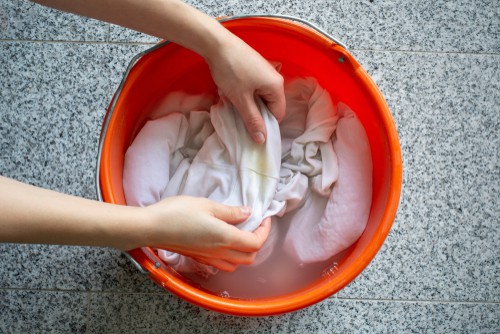
Immediate Action
When you notice a fresh sweat stain on your clothing, taking immediate action can prevent it from setting in permanently.
Blotting the affected area with a clean cloth or paper towel to absorb excess moisture is the first step. Avoid rubbing, as this can spread the stain further.
DIY Sweat Stain Removers
Homemade solutions can be effective in tackling sweat stains. Common household items like vinegar, baking soda, and hydrogen peroxide can be used to create DIY stain removers.
Vinegar, for instance, can be mixed with water to create a solution that is applied to the stain.
Letting the mixture sit briefly before laundering can help break down and lift the stain.
Similarly, a paste made from baking soda and water can be applied to the stain, left to sit, and then gently scrubbed before washing.
Tips for Different Fabrics
Not all fabrics respond to stain removal methods in the same way. Understanding the specific needs of different clothing materials is essential for achieving the best results.
Avoid aggressive scrubbing and opting for gentler stain removal techniques for delicate fabrics like silk or wool.
Testing any stain remover on an inconspicuous area of the fabric before applying it to the stain can help prevent unintended damage.
Commercial Stain Removers
Effective Commercial Products
Commercial stain removers are readily available and can be highly effective.
When choosing a commercial stain remover, look for one specifically designed for the type of stain you’re dealing with, such as protein-based stains.
Follow the manufacturer’s instructions for application and laundering.
Precautions and Considerations
Using store-bought stain removers requires care. Always read and follow the instructions on the product label.
Test the stain remover on a small, inconspicuous area of the garment before applying it to the stain to ensure it doesn’t cause any adverse effects or damage to the fabric.
Long-Term Solutions

Consulting a Professional
In some cases, seeking the expertise of professional dry cleaners may be necessary.
They have access to specialized stain-removing agents and equipment that effectively treat stubborn sweat stains.
Consulting a professional can be best when dealing with valuable or delicate garments.
Lifestyle Changes
Making lifestyle adjustments can contribute to long-term solutions for sweat stains.
These changes can include dietary choices, stress management techniques, and clothing care routines.
Reducing stress levels can minimize excessive sweating, and wearing sweat-resistant undergarments can help protect outer clothing from stains.
Stain-Resistant Clothing
Finally, consider incorporating stain-resistant clothing into your wardrobe. Many clothing manufacturers offer garments designed to resist stains.
These garments are treated with protective coatings that repel liquids, making it less likely for sweat to penetrate the fabric and cause stains.
Frequently Asked Questions about Sweat Stains
Are sweat stains more common in certain fabrics?
Yes, some fabrics, such as silk and cotton, are more prone to sweat stains due to their absorbent nature. Fabrics with moisture-wicking properties are less likely to develop sweat stains.
Can sweat stains be permanently removed from clothing?
In many cases, sweat stains can be removed, especially with prompt treatment. However, for old or set-in stains, complete removal may be challenging.
Are there any natural remedies for preventing sweat stains?
Some natural remedies, like applying lemon juice or baking soda to affected areas, can help prevent sweat stains. However, their effectiveness may vary from person to person.
Can excessive sweating be a medical concern, and when should I consult a healthcare professional?
Excessive sweating, known as hyperhidrosis, can be a medical condition. If you experience persistent and severe sweating, it’s advisable to consult a healthcare professional who can recommend appropriate treatments.
How can I prevent sweat stains on delicate fabrics like silk or wool?
To prevent sweat stains on delicate fabrics, consider wearing sweat-resistant undergarments, applying antiperspirant, and choosing loose-fitting clothing to allow better air circulation.
Sweat Stains on Your Clothes: Causes, Prevention, and Removal – Conclusion
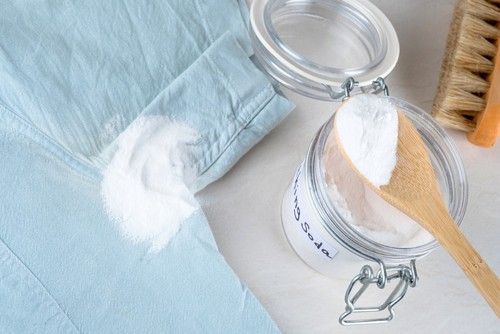
Sweat stains on clothing are a common and persistent issue, but they can be effectively managed with the right knowledge and strategies.
By understanding the causes of sweat stains, adopting preventive measures such as choosing the right clothing practicing proper hygiene, and implementing the appropriate stain removal techniques, you can say goodbye to the frustration of sweat-stained clothes.
Maintaining impeccable attire and confidence is within your reach.
Are you seeking professional and reliable laundry cleaning services in Singapore? Contact us today!
